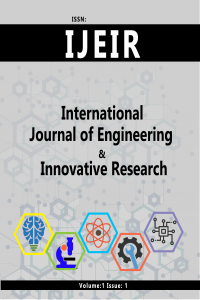New Expansions In The Economic Production Quantity Model Containing Defective Products
Klasik üretim miktarı modellerinde temel varsayım üretilen ürünlerin tamamının kusursuz olmasıdır. Ancak gerçek hayatta bu varsayımın her zaman geçerli olması mümkün değildir. Kusurlu ürünlerin oranının rassal değişken olup, belli bir olasılık dağılımına uyduğu durum için EPQ modelleri incelenmiştir. Literatür incelendiğinde kusurlu ürünlerin tarama hızı, üretim hızına eşit kabul edildiği görülmektedir. Bu çalışmada tarama hızının üretim hızından küçük olması durumu altında bir model geliştirilmiştir. Ayrıca kusurlu ürün oranı rassal değişken olup normal dağılıma ve tekdüze dağılıma uyduğu varsayımı ile örnek bir problem çözümü yapılmıştır.
Anahtar Kelimeler:
EPQ, Kusurlu ürün, tarama hızı
New Expansions In The Economic Production Quantity Model Containing Defective Products
The basic assumption in classical production quantity models is that all of the products produced are free of defect. But in real life, this assumption is not always valid. EPQ models were examined for the situation where the proportion of defective products is a random variable and fits a certain probability distribution. When the literature reviewed, it is seen that the scanning speed of defective products is accepted as equal to the production rate. In this study, a model was developed under the condition that the scanning speed is smaller than the production rate. In addition, a sample problem solution was made with the assumption that the defective product ratio is random variable and corresponds to the normal distribution and uniform distribution.
Keywords:
Defective product, Scan rate, EPQ,
___
- [1] Eroğlu A, Sütçü, A, Sulak, H,(2008). Rassal Olarak Kusurlu Üretim Yapan Üretim Süreçleri İçin Ekonomi Üretim Miktarı Modeli: [Economy Production Quantity Model for Randomly ImperfectProduction Processes.] Gazi Üniversitesi Mühendislik Mimarlık. Fakultesi Dergisi, v.23, n.4, p.23-929.
- [2] Hauck, Z, Rabta, B, Reiner, G (2021). Analysis of screening decisions in inventory models with imperfect quality items. International Journal of Production Research, v.59, n.21, p.6528-6543, doi.org/10.1080/00207543.2020.1818862.
- [3] Rosenblatt, M,J, Lee, H,L, (1986). Economic production cycles with imperfect production processes. IIE Trans. Taylor and Francis Online. v.18, p. 48-55, doi.org/10.1080/07408178608975329.
- [4] Moussawi-Haidar, L, Salameh, M, Nasr, W. (2016). Production lot sizing with quality screening and rework. Applied Mathematical Modelling. v.40 n.4 p.3242-3256, doi.org/10.1016/j.apm.2015.09.095.
- [5] Salameh, M.K, Jaber M.Y,(2000). Economic production quantity model for items with imperfect quality. Int. J. Production Economics, v.64, p.59-64, doi.org/10.1016/S0925-5273(99)00044-4.
- [6] Hayek, P.A, Salameh, M.K, (2001). Production lot sizing with the reworking of imperfect quality items produced. Production Planning and Control. v.12, n.6, p.584-590, doi.org/10.1080/095372801750397707.
- [7] Chiu,S.W, Wang, S.L, Chiu, Y.P, (2007). Determining The Optimal Run Time for EPQ Model With Scrap, Rework, and Stochastic Breakdowns. European Journal of Operational Research, v.180, n.2, p. 664-676, doi.org/10.1016/j.ejor.2006.05.005.
- [8] Eroğlu, A, Gültekin Ö, (2007). An Economic Order Quantity Model With Defective İtems and Shortages. International Journal of Production Economics, v.106, n.2, p.544-549, doi.org/10.1016/j.ijpe.2006.06.015.
- [9] Maddah, B and Jaber, MY. 2008. Economic order quantity for items with imperfect quality: revisited. International Journal of Production Economics, v.112, n.2, p.808–815, doi.org/10.1016/j.ijpe.2007.07.003.
- [10] Khan, M, Jaber, Y, Bonney, M, (2011). An economic order quantity (EOQ) for items with imperfect quality and inspection errors. International Journal of Production Economics, v.133, n.1, p. 113-118, doi.org/10.1016/j.ijpe.2010.01.023.
- [11] Wee, H.M., Wang, W. T., Yang, P. C, (2013). A production quantity model for imperfect quality items with shortage and screening constraint. International Journal of Production Research, v.51, n.6, p.1869-1884, doi.org/10.1080/00207543.2012.718453.
- [12] Maddah, B., Salameh, M.K, Moussawi-Haidar, L, (2010). Order Overlapping: A Practical Approach for Preventing Shortages During Screening. Computers and Industrial Engineering , v.58, n.4, p.691-695, doi.org/10.1016/j.cie.2010.01.014.
- [13] Manna, A. K., Dey, J. K., Mondal, S. K, (2017). Imperfect production inventory model with production rate dependent defective rate and advertisement dependent demand. Computers & Industrial Engineering, v.104, p.9-22, doi.org/10.1016/j.cie.2016.11.027.
- [14] Al-Salamah, M, (2018). Economic Production Quantity with the Presence of Imperfect Quality and Random Machine Breakdown and Repair Based on the Artificial Bee Colony Heurstic. Applied Mathematical Modelling, v.63, n.1, p.68–83, doi.org/10.1016/j.apm.2018.06.034.
- Yayın Aralığı: Yılda 3 Sayı
- Başlangıç: 2018
- Yayıncı: Ahmet Ali SÜZEN
Sayıdaki Diğer Makaleler
Panic Button Mobile Application Usability Study
Ahmet AKCAKAYA, Samet DİRİ, Suhap ŞAHİN, Rukiye SAYRIM YIKILMAZÇINAR
Upscaling Results from Optimum Salinity Waterflooding at the Core Scale to a 3D Dynamic Grid
David ALAİGBA, D. O. ONAİWU, Olalekan OLAFUYİ, Ismaila MOHAMMED
New Expansions In The Economic Production Quantity Model Containing Defective Products
Taoufik KAMOUN, Walid MESLAMENİ
Noise Evaluation In Terms Of Occupational Health And Safety On The Ring Spinning Machine
Murat KODALOĞLU, Feyza AKARSLAN
Applications Of Taguchi Experimental Design Method In The Field Of Textile
